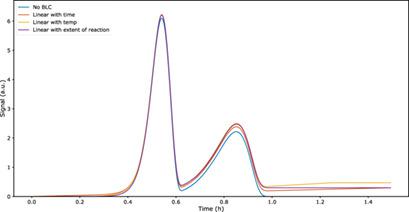当前位置:
X-MOL 学术
›
Chem. Eng. Technol.
›
论文详情
Our official English website, www.x-mol.net, welcomes your
feedback! (Note: you will need to create a separate account there.)
Selection of Formal Baseline Correction Methods in Thermal Analysis
Chemical Engineering & Technology ( IF 1.8 ) Pub Date : 2021-11-23 , DOI: 10.1002/ceat.202100120 Rebecca L. Gibson 1, 2 , Mark J. H. Simmons 2 , E. Hugh Stitt 1 , Lockhart Horsburgh 1 , Robert W. Gallen 1
Chemical Engineering & Technology ( IF 1.8 ) Pub Date : 2021-11-23 , DOI: 10.1002/ceat.202100120 Rebecca L. Gibson 1, 2 , Mark J. H. Simmons 2 , E. Hugh Stitt 1 , Lockhart Horsburgh 1 , Robert W. Gallen 1
Affiliation

|
Baseline correction is a key step in processing of thermal analysis data. Whilst this is a common step, techniques range from linear baselines to use of high-order polynomials. When considering a formal baseline correction (those without physical or experimental justification), only linear correction methods should be used: linear with time, linear with temperature, and linear with extent of reaction. The absence of baseline correction should also be considered. An in silico study shows that the wrong baseline correction can significantly impact the parameters obtained from kinetic modeling. The four baseline correction methods are demonstrated with a mass spectrometry dataset. It is recommended that the selection of correction method should be based on comparison of Akaike weights.
中文翻译:

热分析中形式基线校正方法的选择
基线校正是热分析数据处理的关键步骤。虽然这是一个常见的步骤,但技术范围从线性基线到使用高阶多项式。当考虑正式的基线校正(那些没有物理或实验证明的)时,只能使用线性校正方法:与时间线性、与温度线性和与反应程度线性。还应考虑没有基线校正。计算机研究表明,错误的基线校正会显着影响从动力学建模中获得的参数。使用质谱数据集演示了四种基线校正方法。建议校正方法的选择应基于 Akaike 权重的比较。
更新日期:2021-11-23
中文翻译:

热分析中形式基线校正方法的选择
基线校正是热分析数据处理的关键步骤。虽然这是一个常见的步骤,但技术范围从线性基线到使用高阶多项式。当考虑正式的基线校正(那些没有物理或实验证明的)时,只能使用线性校正方法:与时间线性、与温度线性和与反应程度线性。还应考虑没有基线校正。计算机研究表明,错误的基线校正会显着影响从动力学建模中获得的参数。使用质谱数据集演示了四种基线校正方法。建议校正方法的选择应基于 Akaike 权重的比较。











































 京公网安备 11010802027423号
京公网安备 11010802027423号